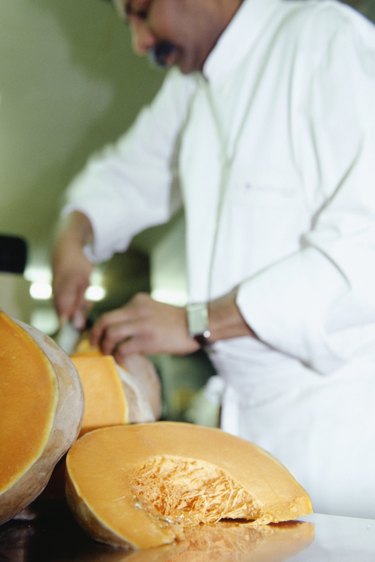Things You'll Need
Water
Knife
Spoon
Large bowl
Ice cubes
Salt
Towel
Plate
Large pot
Slotted spoon

The verb "to blanch" may be used to indicate the process of removing an object's color. In the case of vegetables, however, the meaning is quite the opposite. The process of blanching pumpkins, for example, actually brightens and enhances the natural colors of the vegetable, making the pumpkin more vivid while preserving nutrients, flavor and texture. Blanched pumpkin, like all blanched vegetables, may be cooked, baked, eaten plain or frozen for later use without losing any of its distinct color or character.
Step 1
Wash entire pumpkin. Use a sharp knife to cut stem and bottom off pumpkin. Slice pumpkin in half down center.
Video of the Day
Step 2
Spoon seeds and stringy pulp out of either side of pumpkin. Cut both sides into evenly sized chunks. Do not peel.
Step 3
Fill a large bowl halfway with ice cubes. Add water to cover. Add 1/2 tablespoon of salt per quart of water. Set bowl aside.
Step 4
Line the bottom of a plate with a paper or cloth towel. Set aside.
Step 5
Fill a large pot with water. Salt water liberally until salt-to-water ratio resembles that of ocean water. Do not worry about over-salting. Bring contents of pot to a boil over high heat.
Step 6
Add pumpkin chunks to water. Separate into batches if necessary to keep water at a constant boil. Boil pumpkin only until tender. Test every 30 seconds for completion. Remove from water with slotted spoon, dip into ice bath and taste.
Step 7
Remove pumpkin pieces from water with slotted spoon. Drop pieces immediately into ice bath to shock them. Leave in ice bath for 60 seconds or until cold.
Step 8
Remove pumpkin from ice bath. Transfer to towel-lined plate. Let drain.
Video of the Day
- National Center for Home Food Preservation: Blanching
- The Kitchn: How to Blanch Vegetables
- Dictionary.com: Blanch
- University of Nebraska, Lincoln: Can You Eat Your Jack-o-lantern Pumpkin?
- Real Simple; How to Shock Vegetables; Susie Theodorou
- The Culinary Works; How to Blanch; Mark Parker; July 2008
- O Chef: How & Why to Blanch Vegetables for Freezing